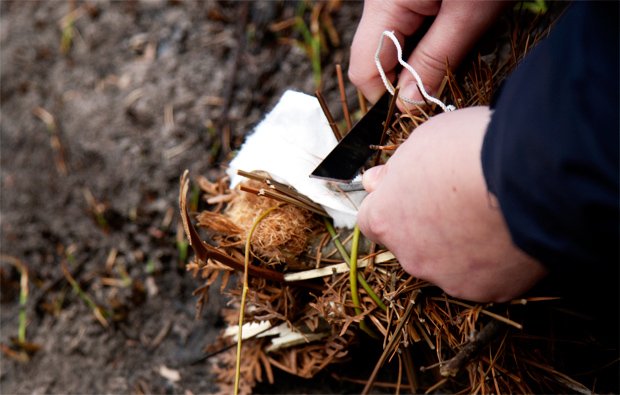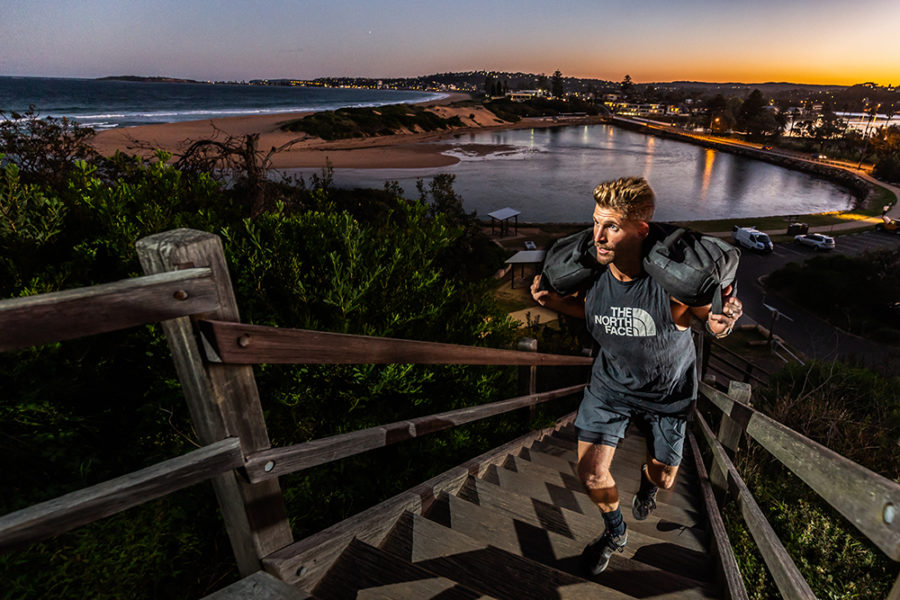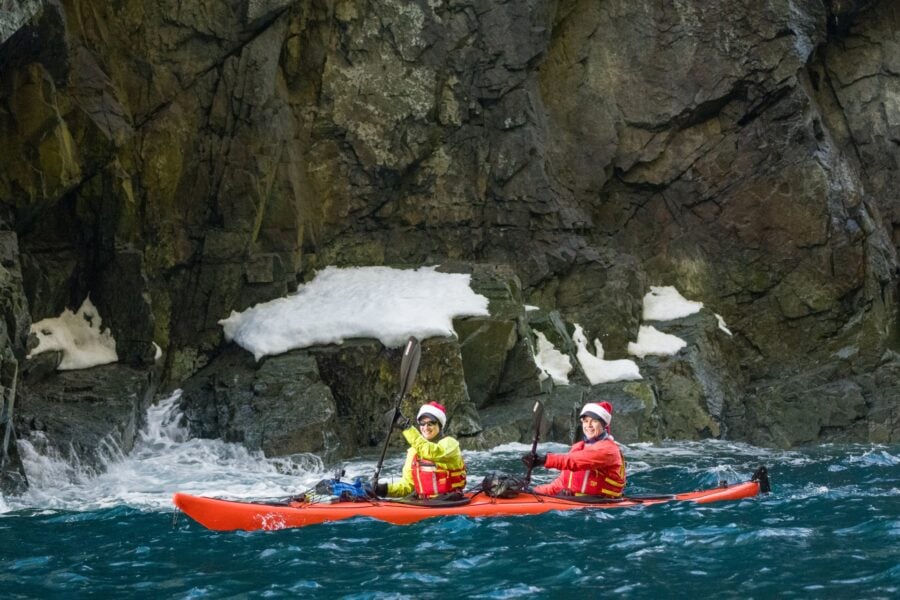Bush survival skills: guide to staying alive

Chris Ord takes an introductory course with one of the world’s leading survival experts, West Australian Bob Cooper.
What kind of name is Bear* anyway? Sounds to me like someone who desperately wants to be famous, not someone I’d trust my life with in the wilderness. (*Okay, so the Bear moniker for Edward Michael Grylls was not actually a TV persona label; rather his sister gave him the nickname when he was only a week old. Fair enough. The fact that he has since legally changed his first name to Bear is not so fair enough.)
Bob, on the other hand. Dependable. Learned. Trustworthy. Could be an accountant. Or a builder. Someone good with strategy. And good with their hands. Yes, Bob. That’s a name you’d trust your life with when it all goes wrong in the Great Outdoors. But surely, you’re asking yourself, if he’s any good, he’d have a world-famous TV show, wouldn’t he? Like that other bloke?
Well, no, actually. Rather than schooling the TV-watching world, three cameramen, a sound bloke and a field producer in how to jump off a cliff into an unknown depth of water (Survival Rule #1: just don’t), this survivalist can usually be found teaching small groups how to avoid getting into trouble in the first place.
Disclosure time: my negatively tinged perception of the most famous survivalist going around is (dis)coloured by an ongoing ‘discussion’ I have with my father – who was also my Scout leader for many years. My argument: Bear Grylls is a menace to outdoors society. His argument: Bear Grylls is an outdoor oracle.
So, I’ve set the challenge to Dad: come and experience a real survival course, led by a real survivalist – one who doesn’t condone jumping off cliffs. West Australian-based Bob Cooper is, in outdoor circles, Australia’s foremost survival expert. Our military consults him, journalists consult him, big mining businesses operating in the harsh outback consult him, people who have had close scrapes in the bush consult him and those who don’t want close scrapes do, too.
Now we find ourselves seated in a bland meeting room, whiteboard up the front, text books and notepads at the ready, rather than out there, in the wilds where we all want to be. Even I, the anti-Bear, had imagined (or hoped) a survival course to be all Lord of the Flies-like, camo geared-up for our bush-food fossicking, shelter-constructing challenges. Instead of rummaging around in the undergrowth, our two-day introductory course is spent partly indoors taking notes from anecdotes that all drive home Bob’s main message: there are no shortcuts to survival and it’s no TV show out there. “The key to survival is the control of your mind,” he says.
Survival tip: panic kills
“You have to maintain control and there is only one thing in the world that any one person can control: their own thoughts and emotions,” says Bob. He notes that doesn’t mean that fear is to be avoided; it just needs to be balanced with a survival kit stuffed full of knowledge.
“Fear in a dangerous situation is natural, don’t mask it. It’s one of five basic emotions and a tremendous energy source, along with adrenaline through the body and cortisone through the brain. When all these are combined, it enables the body and mind to operate at a higher level in times of danger. If fear, adrenaline and cortisone operate on a base of knowledge, then you have a good chance of living,” says Bob. “But the dark side of fear is panic. Panic comes when there is no knowledge to act on. And in survival situations, panic too often leads to death.”
Bob should know. He’s analysed hundreds of survival incidents in the bush and had the odd scrape or 20 himself. “I have been called Lucky Bob, but most of my lucky stories start out with bad luck.”
Like the time a boat overturned on a sandbank miles from shore dumping him into a net with live sharks. Or, after a day working as a pearl diver, getting the bends as night fell and being forced to head back down to 85ft in the pitch black and hang out, knowing sharks were circling. Or the time the helicopter engine stopped at 500 feet. The chopper survived the forced landing in the Great Sandy Desert and he and another guy calmly walked out of an unforgiving desert to go and get help.
Bob also speaks from knowledge gleaned during 30 years as a survival instructor. After years spent working as a commercial fisherman and professional diver, his survival career began when he was invited to work with Special Forces soldiers as an instructor in bush survival. He has since schooled everyone from the Texas Parks and Wildlife Rangers, law enforcement agencies and NASA employees, to celebrities and more than 3000 Joe Publics. On our weekend course his charges include a guy who believes the end of the world is nigh, a teenager who believes he is the next Bear Grylls (and has his own Teen vs Wild YouTube channel to prove it), two outdoor educators, a project manager, a small business owner, a flight attendant, and of course a father and son with ‘issues’.
“I know what it’s like to have your life threatened,” says Bob. “It changes your life.” The problem is that it can also end it. Like the bloke (one of many examples Bob gives us) who became stranded in the Australian outback a few months ago in 42°C heat and decided it was better to walk to look for help in the desert than stay with his vehicle, which had water and other important supplies on board. He died that day less than 30km away.
“Mother Nature is not cruel, but she is unforgiving and doesn’t tolerate fools. Unfortunately that guy’s fear was high and his knowledge low, his emotions overruled common sense. He was driven by fear, he panicked.”
Survival tip: Keeping calm in an emergency
What that bloke, and pretty much every other person who has found themselves in strife in the bush, should do, advises Bob, is to firstly stop and think. And, if you can, have a cup of tea or coffee. Seriously. A satchel of coffee or a teabag is a high-value item in the custom Special Forces survival kit Bob supplies to the military.
“There was the famous case of British soldier Chris Ryan (now also survival celebrity and prominent author of military adventure novels). He was the only member of an eight-man SAS mission, Bravo Two Zero, to evade the enemy over 322 tortuous kilometres after a behind-enemy-lines mission went wrong in the first Gulf War. One of the team members named the teabag in his kit as the thing that kept his morale most alive,” says Bob, who worked with Chris on the Australian-based outback finale of the reality TV show, Britain’s Toughest Family.
“Again, it’s the mental thing. The psychological boost of something as simple as a teabag can change your mindset, calm you and allow you to think more rationally, which is the key to survival.”
Once sheltered, Bob advises us to write down five major wilderness survival priorities: water, signals, shelter, warmth and food then muse on them. Surprisingly, in general, food is the lowest priority. In all of Bob’s research he has come across no evidence of anyone starving to death in an Australian survival situation.
Survival tip: Urine is not a substitute for water
Water is usually high up on the needs list; especially in warmer weather (food rises up the list in colder situations where the body needs more calories to maintain circulation).
If fluids are not replaced the first thing to go is the mind, which Bob has already established is your biggest tool in self-rescue. The loss of just 2L of body fluid, which in hot climates can happen in under three hours, can impair brain function by 25 per cent. A quarter of your common sense gone is a dangerous thing.
Bob covers numerous methods of water procurement, including collecting dew from surfaces, plants and grasses; recognising and following fresh animal tracks to water; observing the flight directions of seed-eating birds (headed towards water they fly in neat formation; while flying away, they are more haphazard in their formation); draining your car’s air-conditioning water by running the air-con with windows down and collecting the overflow in a container or bag; digging solar stills to collect evaporated water from impure sources; and draining water from plant roots.
On one of our first forays outside the classroom, our small group experiments with yet another method: clear plastic bags tied over tree branches. Water is collected as leaves transpire inside the bag, the water beading and pooling.
“Half a litre to a litre per day is what you’d expect in general, depending on conditions,” says Bob of the plastic-bag method. “Obviously you need to rely on several techniques of water collection to get enough.”
And no, warns Bob, drinking your own urine is not on the list. “Uric acid isn’t great for you,” says Bob.
With all water consumption the advice is never sip. “Drink a cupful at a time,” says Bob. “If you sip water, the first mouthful goes to your digestion, the second to your liver and kidneys and none gets to your brain.”
Another important point once you have established your water source, plentiful or otherwise, is to make sure that it doesn’t make you sick: the last thing you need when water and food is scarce is to get diarrhoea or worse. Which brings us to fire: a great tool for purifying your water, if you know how to create a flame.
Survival tip: hone your fire-lighting skills
“Fire is also important with regards to giving psychological comfort, and for warmth, cooking and emergency signals,” adds Bob. “The list of uses for fire adds up to 20.” So, yes, knowing how to light one is imperative in a survival situation.
Bob instructs us to fossick for various sized branches and foliage and then teaches us how to construct a tripod platform fire designed to smoke conspicuously for daytime signalling. Ostensibly, it’s a lesson in the art of bonfire building, and thus our testosterone-heavy group passes this particular exercise with flying colours.
We’re taught other methods of signalling, too: the best way to attract the attention of an aircraft (with a signalling mirror), common signals and their meaning (three of anything including signal fires, light flashes or whistle blasts, is known internationally as a sign of distress), ground-to-air signals, and of course written notes, with pointers as to what information to include for rescuers looking for you.
But it’s the mention of the essence of fire craft that gets our group energised: the art of creating fire from two sticks, a bit of friction, sweat and a whole lot of swearing.
“Well, I’ve done it more than 500 times,” says Bob, who reckons you should be able to do it in under 10 minutes when practised, two minutes if you’re good at it and one minute if you’re Bob Cooper. “But I’d still never want to bet my life on being able to create fire from rubbing two sticks together. I prefer to make sure I have at least two other, more reliable methods of fire lighting on me whenever I go bush. Stone-age fire lighting is an absolute last resort, but is still a skill all survivalists should possess.”
There’s something ritualistic or tribal about the fervour that comes over us all as we gather our sticks and twine and thrust the ‘bow’ we’ve made back and forward. This in turn spins the wooden shaft, which
has its head buried in a base plate of wood and some tinder. For us, the father-son duo, it’s not to be. Perhaps we should have mastered this years ago in Scouts, if only my Scout-leader father had been more badge happy.
A waft of smoke goes up behind us – the star of Teen vs Wild is on a blazing winner. Another lights up. And another. We have smoke, but no fire. Bob leans over us, picks the problem (a termite-eaten dud fire stick) and offers his own as a replacement. The length of wood must be infused with his powers, as a few spins later we’re alight. Just. And it could be from the heat of our frustration as much as the friction of wood on wood. Bob’s like the proud father, but there’s a lingering look in his eyes that still says: “Wouldn’t wanna rely on it in an emergency would you?”
No.
Survival tip: know your environment
“Knowing how to survive is about knowing the environment and how it operates, and how to read it,” says Bob. “It’s about observation. But it’s also about things like human biology – knowing how your body operates, especially under different types of stress. If you know these things, you can work on how to deal with different scenarios and how to make the correct decisions to save your life.”
As much as knowledge gained, Bob is big on respect playing a huge role in surviving the great outdoors.
“When fear and knowledge meet in the middle, that’s what I call respect.” Bob learned his respect spending time with Australia’s Western Desert Aboriginal people (he is a ‘skin named’ member of a clan), along with indigenous groups on the land in the Kalahari, Botswana, with the Sioux Indians in Dakota, USA, and the Orang Asli people of Malaysia.
During the course, Bob talks of a survival learning curve that swings from unconscious incompetency through conscious incompetency, conscious competency, and the ideal of unconscious competency. What his course does in my mind is firmly peg me (and my Dad) to a number two – conscious incompetency – on the stepping-stone to survival Yoda-ness.
“But at least you’re thinking about it,” assures Bob. “If you’re at least aware and thinking about scenarios then you’ve a minimum of 10 per cent better chance of living.”
The steps through the final phases are big ones, according to Bob. Conscious competency is the aim of his longer, 10-day courses, which take survival students into the Pilbara region of Western Australia for more intensive, in situ learning.
One of the key messages Bob wants his students to come away with from any of his courses is a healthy respect for the wild. “Nature gives you everything you need to survive, not always what you want but what you need. You will get back what you give out – give out respect and it will be returned to you.”
That sense of respect shines through Bob in his humbleness. “I’m part of this group,” he tells us at the beginning. “I’m classified as an expert but that’s just a legal term. I’m still a student, and I expect I’ll learn a few things over the next few days as well. I always do on these courses.”
In spending time with Bob the teacher and Bob the student, one lesson becomes crystal clear: a Bear in the bush isn’t worth two Bobs in a classroom.




